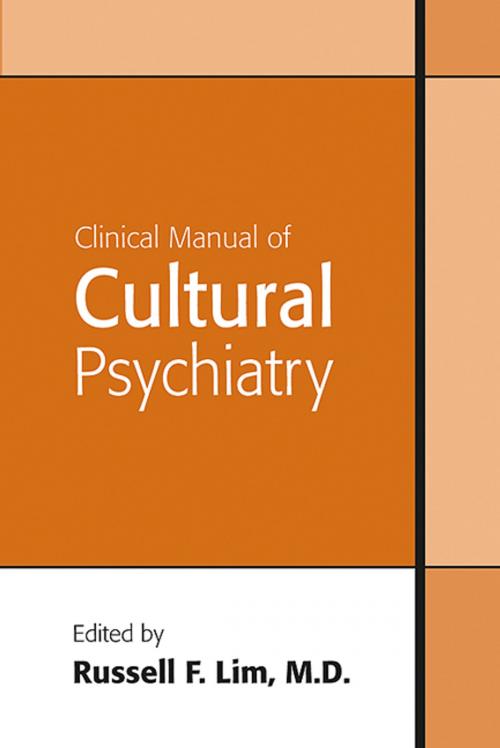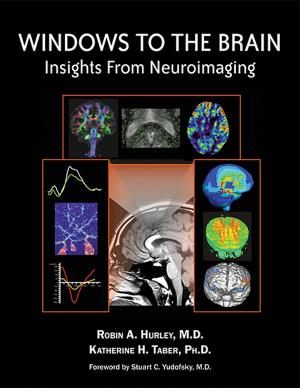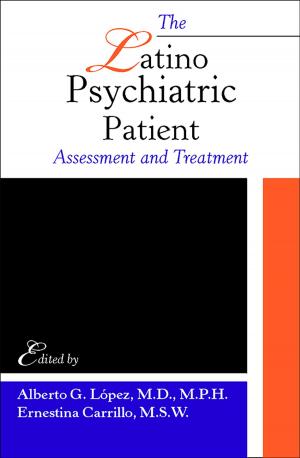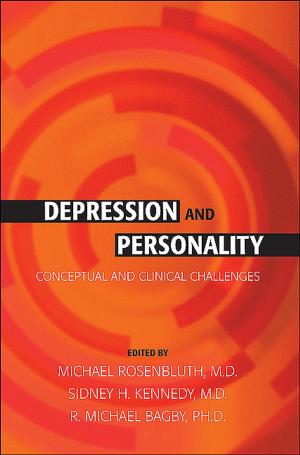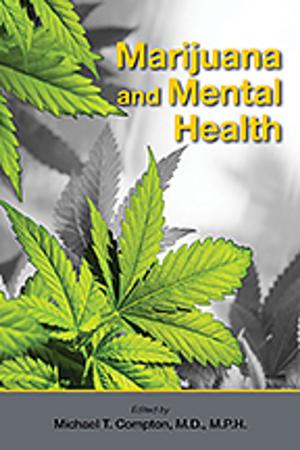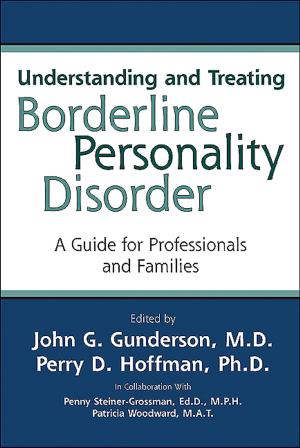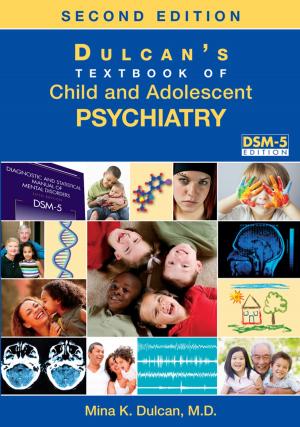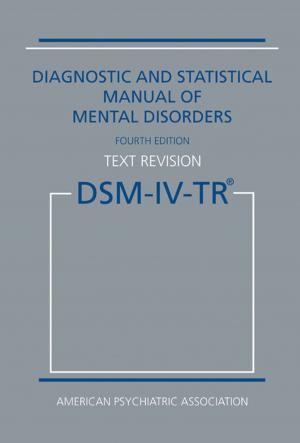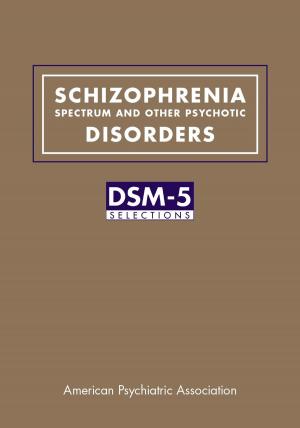Clinical Manual of Cultural Psychiatry
Nonfiction, Health & Well Being, Medical, Specialties, Psychiatry| Author: | ISBN: | 9781585626526 | |
| Publisher: | American Psychiatric Publishing | Publication: | April 2, 2007 |
| Imprint: | American Psychiatric Publishing | Language: | English |
| Author: | |
| ISBN: | 9781585626526 |
| Publisher: | American Psychiatric Publishing |
| Publication: | April 2, 2007 |
| Imprint: | American Psychiatric Publishing |
| Language: | English |
Representing the clinical state of the art in culturally competent assessment and treatment, and providing important information on the four main racial/ethnic minority groups (African Americans, Asian Americans, Latinos/Hispanics, and Native Americans and Alaska Natives), the Clinical Manual of Cultural Psychiatry synthesizes the collected wisdom from the editor's 10 years of teaching cultural psychiatry with the professional experience of seven other contributors in using and teaching about DSM-IV's Outline for Cultural Formulation.
Following an initial chapter about how the influence of culture affects every level of the mental health system, and how clinicians can gain insight into the complex interplay between culture and mental illness to ultimately improve patient care, six subsequent chapters by 8 authors use numerous illustrations and clinical vignettes as they address Issues for assessing and treating African Americans -- Presents a framework and context for understanding African Americans and their attitudes, beliefs, and behaviors about mental health and mental illness. Raises awareness of racism, underdiagnosis, and misdiagnosis as they affect assessment and treatment. Issues for assessing and treating Asian Americans -- Details the need for an empathic, non-confrontational approach in evaluation and therapy to understand the Asian American patient's culture, health beliefs, and life philosophies and therefore improve the potential to engage them in treatment. Issues for assessing and treating Latinos/Hispanics -- Discusses the need for direct personal relatedness, perceived clinician warmth, and active family engagement in treatment as key skills in promoting the therapeutic alliance and participation among patients from this diverse and yet culturally cohesive group. Issues for assessing and treating Native Americans -- Provides social and historical information (e.g., context of past events such as massacres of entire villages, disease epidemics, and forced removal from ancestral lands; present factors such as social stressors and level of involvement in tribal life) for clinicians to build their understanding of this most underserved ethnic group in the US. Issues in Ethnopsychopharmacology -- Reviews clinical reports of ethnic variation with several different classes of psychotropic medications and examines the relationship of pharmacogenetics, ethnicity, and environmental factors (including the use of traditional herbal preparations) to pharmacologic treatment of minorities. Three Appendices -- Including "A Resident's Guide to Cultural Formulation," with assessment tips written by American Psychiatric Association (APA) Minority Fellows; an "Annotated Bibliography of Cultural Psychiatry and Other Topics; and a "Glossary of Culture-Bound Syndromes."
Clinicians must now meet accreditation standards involving cultural competence, making this groundbreaking clinical manual, with its three appendixes and index, indispensable for mental health care educators, students, residents, and practitioners. The Clinical Manual of Cultural Psychiatry will also prove invaluable for encouraging much-needed research, as we seek to better understand our increasingly diverse -- and ever smaller -- world.
Representing the clinical state of the art in culturally competent assessment and treatment, and providing important information on the four main racial/ethnic minority groups (African Americans, Asian Americans, Latinos/Hispanics, and Native Americans and Alaska Natives), the Clinical Manual of Cultural Psychiatry synthesizes the collected wisdom from the editor's 10 years of teaching cultural psychiatry with the professional experience of seven other contributors in using and teaching about DSM-IV's Outline for Cultural Formulation.
Following an initial chapter about how the influence of culture affects every level of the mental health system, and how clinicians can gain insight into the complex interplay between culture and mental illness to ultimately improve patient care, six subsequent chapters by 8 authors use numerous illustrations and clinical vignettes as they address Issues for assessing and treating African Americans -- Presents a framework and context for understanding African Americans and their attitudes, beliefs, and behaviors about mental health and mental illness. Raises awareness of racism, underdiagnosis, and misdiagnosis as they affect assessment and treatment. Issues for assessing and treating Asian Americans -- Details the need for an empathic, non-confrontational approach in evaluation and therapy to understand the Asian American patient's culture, health beliefs, and life philosophies and therefore improve the potential to engage them in treatment. Issues for assessing and treating Latinos/Hispanics -- Discusses the need for direct personal relatedness, perceived clinician warmth, and active family engagement in treatment as key skills in promoting the therapeutic alliance and participation among patients from this diverse and yet culturally cohesive group. Issues for assessing and treating Native Americans -- Provides social and historical information (e.g., context of past events such as massacres of entire villages, disease epidemics, and forced removal from ancestral lands; present factors such as social stressors and level of involvement in tribal life) for clinicians to build their understanding of this most underserved ethnic group in the US. Issues in Ethnopsychopharmacology -- Reviews clinical reports of ethnic variation with several different classes of psychotropic medications and examines the relationship of pharmacogenetics, ethnicity, and environmental factors (including the use of traditional herbal preparations) to pharmacologic treatment of minorities. Three Appendices -- Including "A Resident's Guide to Cultural Formulation," with assessment tips written by American Psychiatric Association (APA) Minority Fellows; an "Annotated Bibliography of Cultural Psychiatry and Other Topics; and a "Glossary of Culture-Bound Syndromes."
Clinicians must now meet accreditation standards involving cultural competence, making this groundbreaking clinical manual, with its three appendixes and index, indispensable for mental health care educators, students, residents, and practitioners. The Clinical Manual of Cultural Psychiatry will also prove invaluable for encouraging much-needed research, as we seek to better understand our increasingly diverse -- and ever smaller -- world.
